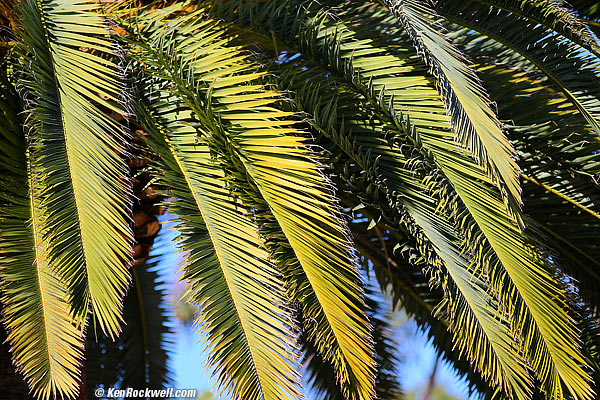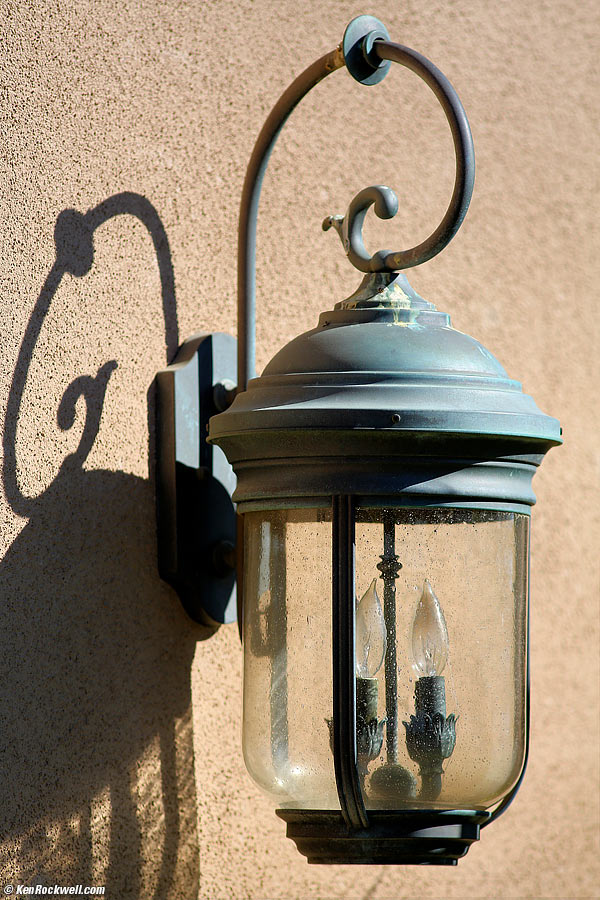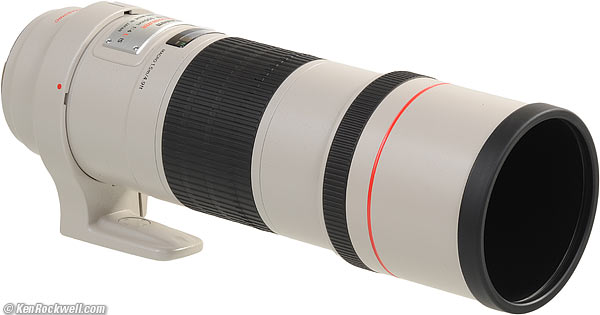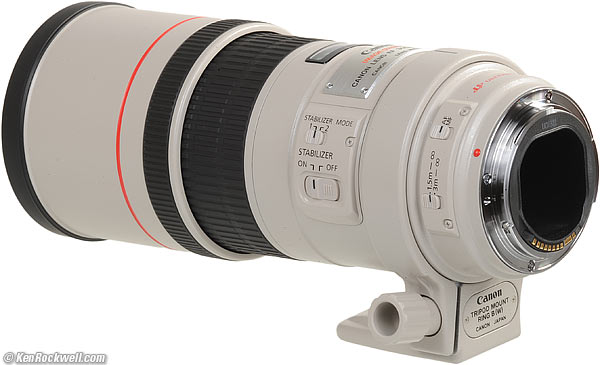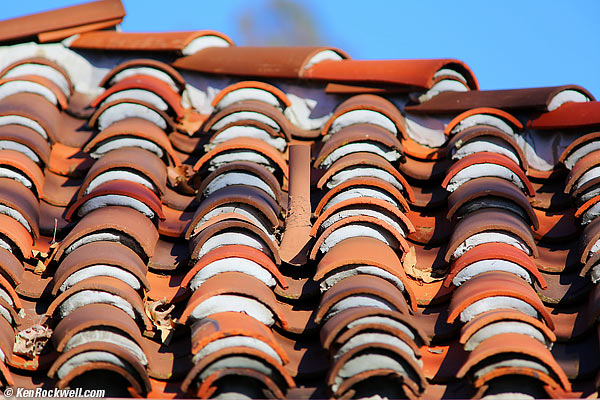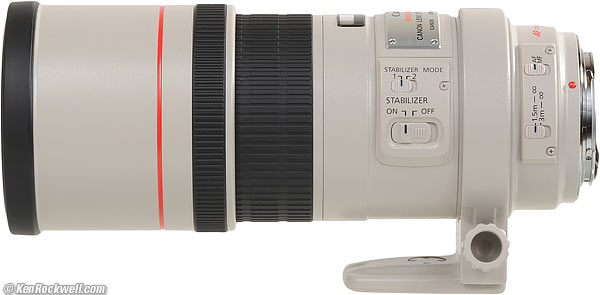Home Donate New Search Gallery Reviews How-To Books Links Workshops About Contact
Canon 300mm f/4 L IS
EF (1997-)
© 2015 KenRockwell.com. All rights reserved.
Sample Images Intro Specs Performance
Compared Usage Recommendations More
Canon EF 300mm f/4 L IS (Full-frame, 1.3x and and APS-C coverage, 77mm filters, 41.6 oz./1,180g lens only, 45.8 oz./1,298g with collar, 4.9'/1.5m close focus, about $1,350 after rebate). enlarge.
I got mine at this link to it at Adorama; this link to it at Amazon is also a great place to get it. This all-content, junk-free website's biggest source of support is when you use those or any of these links to approved sources when you get anything, regardless of the country in which you live. It helps me keep adding to this free website when you get anything through these links — but I receive nothing for my efforts if you take the chance of buying elsewhere. Never buy at retail, since Canon doesn't seal its boxes so you can't tell if it's a used or damaged lens. Thanks for your support! Ken.
January 2015 Canon Lenses Canon Reviews All Reviews
Why fixed lenses take better pictures
Sample Images top
Sample Images Intro Specs Performance
Compared Usage Recommendations More
Palm, 19 December 2014. Canon 5D Mark III, Canon EF 300mm f/4 L, f/4 (wide open) at 1/800 at ISO 100, no lens profile used, Athentech Perfectly Clear v2.) Full resolution.
Lamp, 19 December 2014. Canon 5D Mark III, Canon EF 300mm f/4 L, f/4 (wide open) at 1/1,000 at ISO 100, no lens profile used, Athentech Perfectly Clear v2.) Full resolution.
Introduction top
Sample Images Intro Specs Performance
Compared Usage Recommendations More
This Canon 300mm f/4 is high performance, fast and lightweight telephoto lens for every Canon DSLR and 35mm EOS camera. It has great optics, fast autofocus and top-notch build quality.
While most people prefer a 70-300 or 100-400mm zoom, other people prefer this fixed 300mm f/4 to Canon's 70-300 zooms for it's higher speed (better for action shots) and better optical quality. It's preferred over Canon's 100-400mm zooms for its lighter weight, lower price and higher speed.
Just grab the focus ring at any time for instant manual-focus override.
The tripod collar slides off the back, but leaves several metal nubbins poking out.
This professional L lens is a bargain today because it's been in Canon's catalog so long. Canon has long since paid for its development cost, so it sells for much less than similar but newer lenses. The only gotcha is that this is one of Canon's first Image Stabilization lenses, and thus IS doesn't work to speeds as slow as do newer lenses.
It's much lighter than 70-200/2.8 or 100-400mm zooms, and much sharper than a 70-200mm with a teleconverter.
Specifications top
Sample Images Intro Specs Performance
Compared Usage Recommendations More
Canon EF 300mm f/4 L IS. enlarge.
Name
Canon calls this the CANON LENS IMAGE STABILIZER EF 300mm f/4 L IS.
IMAGE STABILIZER and IS mean that you don't need a tripod.
EF means "electronic focus;" there is an autofocus motor inside the lens.
L means as expensive as L.
Optics top

Canon EF 300mm f/4L IS internal diagram. UD Glass.
15 elements in 11 groups.
Multicoated.
Internal focussing.
Focal Length
300mm.
When used on an APS-C camera, it sees an angle of view similar to what a 485mm lens sees when used on an FX or 35mm camera.
Angle of View, full frame
8.2º diagonal.
4.5º vertical.
6.8º horizontal.
Diaphragm top
Canon 300mm f/4L IS at f/4. (EF diaphragm not visible).
8 straight blades.
Stops down to f/32.
Close Focus top
4.9 feet (1.5m) from the image plane.
Maximum Reproduction Ratio top
1:4.2 (0.24x).
Image Stabilizer top
Rated two stops improvement.
Hard Infinity Focus Stop? top
No.
Focus Scale top
Yes.
Depth-of-Field Scale top
No.
Infra-Red Focus Index top
No.
Filters top
77mm.
Size top
Canon specifies 3.5" (90 mm) diameter by 8.7" (221 mm) long.
Weight top
45.770 oz. (1,297.5g), actual measured, with collar.
41.617 oz. (1,179.9g), lens alone without collar.
4.150 oz. (117.7g), collar alone.
Canon specifies 42.0 oz. (1,190g).
Hood top
Built-in telescoping hood.
Hood locks in extended position with screw threads, bravo!
Canon EF 300mm f/4 L IS with hood extended. enlarge.
Caps top
New 77mm Canon pinch-type front cap and standard EOS rear cap.
Tripod Collar top
The tripod collar comes off from the back.
It's called the Tripod Mount Ring B (W). The 180/3.5 Macro uses the same ring, in black: Tripod Mount Ring B (B).
Case top
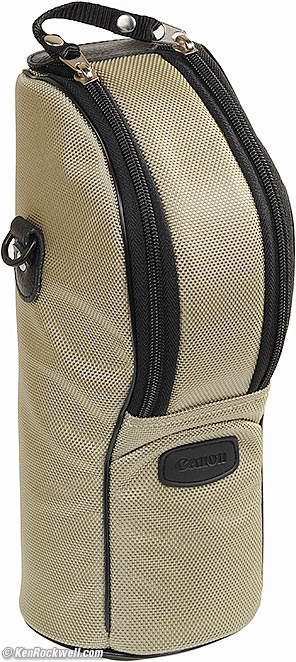 |
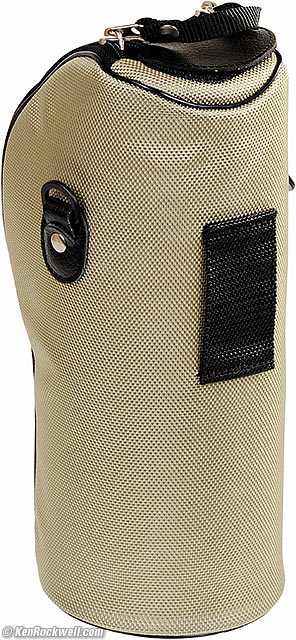 |
Canon LZ1128. bigger. |
Canon LZ1128. bigger. |
Canon includes a very nice padded nylon LZ1128 case.
This is a very useful sturdy padded case. You can use the double-handled zipper for solid closing, and once open, there's velcro on the top for shot-to-shot open and closing. Bravo!
Introduced top
March 1997.
Canon Model Number top
2530A004.
Included top
Lens.
Tripod collar.
Caps.
Price, USA top
2014 December: $1,350 after rebate.
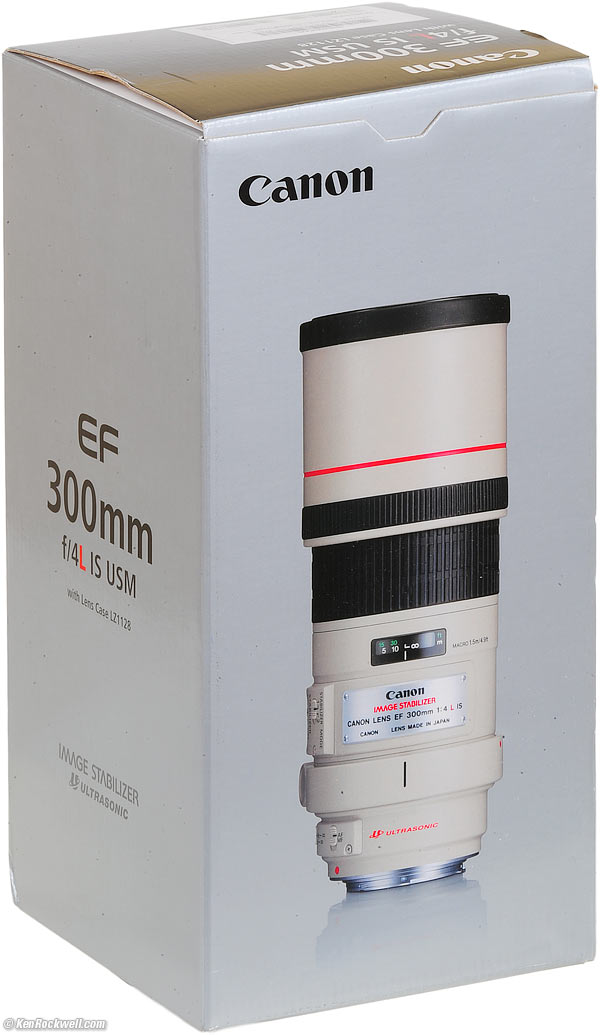
Box, Canon 300/4 IS.
Performance top
Sample Images Intro Specs Performance
Compared Usage Recommendations More
Overall Focus Bokeh Coma Distortion
Ergonomics Falloff Filters Focus Breathing
Color Fringes Image Stabilization Macro
Mechanics Sharpness Sunstars Teleconverters
Overall performance top
The Canon 300mm f/4 L is sharp and easy to use.
Focus performance top
Auto/Manual Switching
Just grab the ring anytime for instant manual-focus override.
AF Speed
AF is fast; not instantaneous, but fast.
It's a little faster than the original 300mm f/2.8 L.
AF Accuracy
AF is always dead-on.
Bokeh performance top
Bokeh, the quality of out-of-focus areas as opposed to the degree of defocus, is swell.
Backgrounds get very soft and never distract. That's why 300mm lenses are a top pro choice for portrait lenses.
Here's a full-frame sample. Click to enlarge:
At f/4. enlarge.
Coma performance top
I see no coma. It's sharp right out to the corners, even at f/4.
Distortion performance top
There is no visible distortion.
For more critical use, use these values in Photoshop's Lens Distortion tool to remove it:
100' (30m) |
-1.2 |
30' (10m) |
-0.5 |
10' (3m) |
-0.5 |
4.9' (1.5m) |
-0.7 |
© 2015 KenRockwell.com. All rights reserved.
Ergonomics performance top
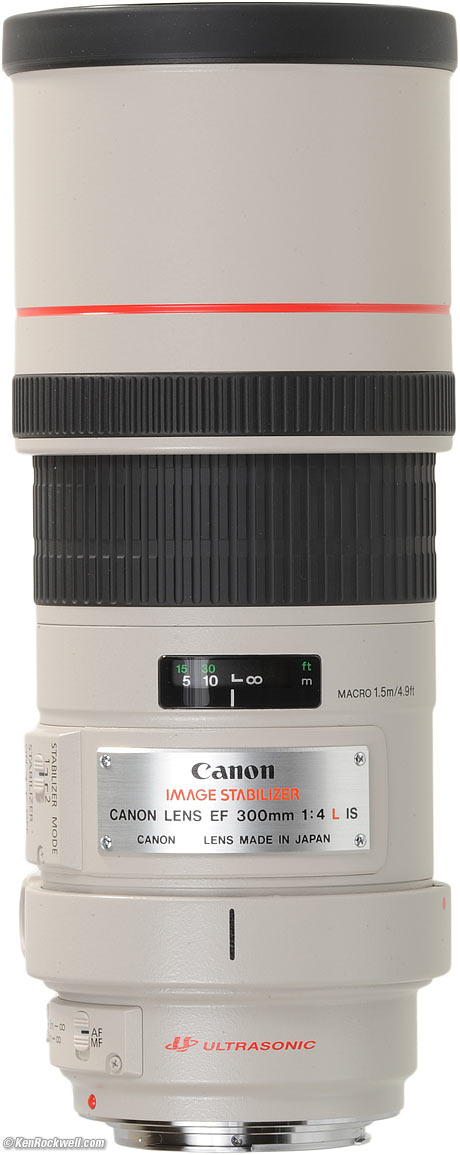
Canon EF 300mm f/4 L IS USM.
It's great that the hood is built in, and locks so it's not always getting pushed back. The hood is tough plastic, with a tough rubber bumper on the front.
The only weird thing is that the AF/MF switch is farther back than you'd expect, so you have to take the camera down from your eye in order to set MF or AF.
Falloff (darkened corners) performance top
Falloff is invisible. It's negligible wide-open, and gone by f/5.6, even without a lens correction profile.
I've greatly exaggerated this by presenting it against a gray background. In actual photography, it's invisible.
Canon 300mm f/4 falloff on full-frame, no correction.
© 2015 KenRockwell.com. All rights reserved.
|
Filters, Use with performance top
There's no problem with vignetting, even using a stack of ordinary 77mm filters.
Focus Breathing performance top
Focus breathing (the image changing size as focused) is mostly of interest to cinematographers who don't want the image changing size ("breathing") as the lens is focused among different subjects.
The image from the 300/4 IS gets a little larger as focussed more closely.
Lateral Color Fringes performance top
There is little to no green-magenta lateral color fringing without a lens profile.
With a lens profile, there will be absolutely none.
This is very good performance.
Image Stabilization performance top
This has one of Canon's first implementations of Image Stabilization.
It's much better than none at all, while the newest IS systems, like that in the 100-400mm II, work to much slower speeds.
I usually get perfectly sharp shots at 1/60, and half the time at 1/30. With the 100-400 II, I get sharp shots most of the time at 1/15, about two stops better than with this lens.
While newer IS systems are silent, this IS system makes a noise similar to a small motor or water running inside the lens.
Macro performance top
Macro gets close. Here's what you get on full-frame at the close-focus distance:
Longines 23ZS at close-focus distance at f/4.
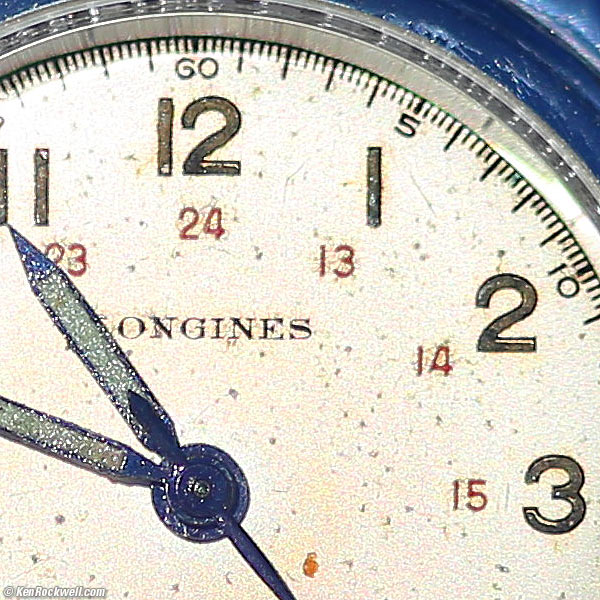
Crop from above at 100%. If this is about 6" (15cm) on your screen, printing the complete image at this same high magnification would result in a 40 x 60" (100 x 150 cm) print!
This is super-sharp, and it's wide-open at f/4. Stop down and it ought to get even better. What look like chromatic problems are actually caused by the plastic watch crystal, and what looks like noise is the surface of the 60-year-old wristwatch.
Mechanics performance top
Rear, Canon 300mm f/4 L IS, showing UC0321 date code. enlarge.
The Canon 300mm f/4 L is built very well, mostly made of metal.
Hood
Tough plastic.
Rubber bumper on front.
Locks.
Filter Threads
Plastic.
Forebarrel
Metal.
Focus Ring
Rubber covered metal.
Focus Cam
Metal.
Internals
Mostly metal.
Mid Barrel
Metal.
Tripod Collar
Metal.
Rear Barrel
Metal.
Identity
Engraved metal plate.
Mount
Metal.
Markings
Painted.
Serial Number
Engraved into bottom rear of barrel and filed with black paint.
Date Code
Printed on rear light baffle as shown above.
Mine has date code UC0321, meaning my sample was made in Canon's Utsunomiya plant in March 2014.
Rear Gasket (moisture seal at mount)
No.
Noises When Shaken
Very mild clunking.
Quality
Made in Japan.
Sharpness performance top
Image sharpness depends more on you than your lens, and lens sharpness doesn't mean much to good photographers. It's the least skilled hobbyists who waste the most time blaming fuzzy pictures on their lenses, while real shooters know that few photos ever use all the sharpness of which their lenses are capable due to subject motion and the fact that real subjects are rarely perfectly flat.
The Canon 300mm f/4 is very sharp, better than most Canon zooms. That's why people use it.
If you can't get an ultrasharp image from this lens, you're doing something wrong. It could be haze or heat shimmer in warm weather, or subject or camera motion, or the simple fact that there is no depth of field at f/4 at 300mm. See also Fixing unsharp images.
Here's Canon's MTF curve, which shows engineers just how nearly perfect it is:

Canon EF 300mm f/4 L IS MTF Curve.
Sunstars performance top
With its straight 8-bladed diaphragm, this Canon 300mm f/4 makes Canon-typical 8-pointed sunstars on brilliant points of light.
Teleconverters performance top
Canon EF Extender 1.4x II
Palm, 19 December 2014. Canon 5D Mark III, Canon EF 300mm f/4 L with Canon EF Extender 1.4x II at f/5.6 (wide open) at 1/640 hand-held at ISO 100, no lens profile used, Athentech Perfectly Clear v2.) Full resolution.
It works well with the Canon EF Extender 1.4x II, making it a 420mm f/5.6.
Autofocus is reasonably fast, and it's reasonably sharp.
Without a lens profile, there are some magenta-green lateral color fringes. Load a lens profile and these will go away.
Canon EF Extender 2x II
The Canon EF Extender 2x II makes this a 600mm f/8.
As an f/8 lens, only the center AF point works on my 5D Mk III and 7D Mk II.
Autofocus works, but it will get stuck if you're too far out of focus. Help the lens by using the manual ring to get it close to being in focus, and AF will take you from there.
It's reasonably sharp, but look out for heat shimmer problems if shooting at long distance outdoors. The lens will magnify the natural distortions in the air if there are temperature differences.
Without a lens profile, there are magenta-green lateral color fringes. Load a lens profile and these will go away.
Compared top
Sample Images Intro Specs Performance
Compared Usage Recommendations More
See Canon 300mm Lenses Compared.
Versus 100-400mm zooms
This 300/4 is significantly lighter than the 100-400mm zooms.
It's also a stop faster than the 100-400mm zooms.
The 100-400 II focuses a bit faster.
While the 100-400 II has a much better IS system, this lens is a stop faster. For sports and action, this lens is better, while for dim-light no-tripod use, the new 100-400mm IS II is better — if you want to carry it.
Versus 70-200mm zooms with converters
This lens generally works better than fumbling with a 70-200/2.8 and a 1.4x converter.
This lens works much better than a 70-200/4 and a converter, since it's much faster.
Versus the original EF 300mm f/2.8 L
The original 300mm f/2.8 L doesn't focus quite as fast, but they're about the same in actual use.
The 2.8 weighs a ton by comparison.
Optics are excellent in both of these.
Since the f/2.8 is faster, the 2x extender works very well with it.
Usage top
Sample Images Intro Specs Performance
Compared Usage Recommendations More
Canon 300/4L IS.

Controls, Canon 300mm f/4 L IS.
Stabilizer Mode
Use MODE 1.
MODE 2 is for panning.
Stabilizer
Leave it on, except on a tripod.
Focus Range Limiter
Use the 1.5m-∞ range.
If your conditions are causing to the lens waste time "hunting" at close distances for focus, select the 3m-∞ range and you'll stop the lens from trying to focus closer than 3 meters (10 feet).
AF — MF
Use AF. In AF, it autofocuses, and you can grab the focus ring at any time for instant manual focus override.
M is manual focus only and locks-out autofocus. Use this only if you don't want the AF system to try to focus.
Recommendations top
Sample Images Intro Specs Performance
Compared Usage Recommendations More
This lens is for photographers who demand the highest optical quality, and are willing to forego the convenience of a zoom to get it. It also weighs much less than the 70-200/2.8 and 100-400mm zooms.
Photographically, a 300/4 throws backgrounds much further out of focus than a 70-200 does at 200mm. This is why the 300/4 makes a great portrait and headshot lens. It lets us stand farther away for better facial rendering (perspective), and at f/4 blows-out any annoying background into a wall of soft color far better than any 200mm lens can at f/2.8.
If money and weight are no object, I prefer the new 100-400mm IS II, but if you don't need a zoom and don't need great Image Stabilization — or if you prefer its faster aperture, lower cost or lighter weight — then get this 300/4 IS.
More Information top
Sample Images Intro Specs Performance
Compared Usage Recommendations More
Canon USA's page on the 300mm f/4 IS.
Help me help you top
I support my growing family through this website, as crazy as it might seem.
The biggest help is when you use any of these links when you get anything, regardless of the country in which you live. It costs you nothing, and is this site's, and thus my family's, biggest source of support. These places have the best prices and service, which is why I've used them since before this website existed. I recommend them all personally.
If you find this page as helpful as a book you might have had to buy or a workshop you may have had to take, feel free to help me continue helping everyone.
If you've gotten your gear through one of my links or helped otherwise, you're family. It's great people like you who allow me to keep adding to this site full-time. Thanks!
If you haven't helped yet, please do, and consider helping me with a gift of $5.00.
As this page is copyrighted and formally registered, it is unlawful to make copies, especially in the form of printouts for personal use. If you wish to make a printout for personal use, you are granted one-time permission only if you PayPal me $5.00 per printout or part thereof. Thank you!
Thanks for reading!
Mr. & Mrs. Ken Rockwell, Ryan and Katie.
Home Donate New Search Gallery Reviews How-To Books Links Workshops About Contact


